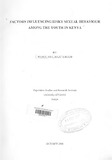| dc.description.abstract | Information on risky sexual behaviour has significant policy implications in designing
and implementing family planning and HIVIAIDS prevention programs. The main
objective of this study was to explore the factors that determine risky sexual behaviour
and the possible risk to HIV infection among the youth in Kenya.
The study population consisted of 2132 sexually-active women ages (15-24) covered in
the KDHS conducted in 2003.The study variables were highest level of education, work
status, age, marital status, place of residence, media exposure, knowledge of HIVIAIDS
prevention methods, perception of HIV risk of infection, rel~gion, HIV IAIDS prevalence
regimes and risky sexual behaviour as the response variable. In addition, 32 women were
interviewed to provide further insights concerning risky sexual behaviour.
The technique for quantitative data analysis erriployed was Logistic Regression model.
Additionally, field data gathered from focus group discussions were categorised
thematically. From cross tabulation results, it was established that there were differentials
in reporting of risky sexual behaviour across all characteristics of women. Factors found
to be significant included; age, highest education levels, place of residence, religion,
exposure to mass media, knowledge of HIVIAIDS prevention methods, marital status and
HIV/AIDS prevalence regimes. Logistic regression model 'showed. that age, marital
status, education level, media exposure, knowledge of HIV IAIDS prevention methods
and HIVIAIDS prevalence regimes were, important determinants of risky sexual
behaviour among the female youth.
The major conclusion derived from the study findings was that although levels of
"-
knowledge of HIVIAIDS prevention methods were very high among the young women,
various socio-cultural, economic, demographic and psychosocial factors influenced the
youth's risky sexual behaviour. These factors led the young women to engage in risky
sexual behaviour that obviously might lead to HIV infection.
--
v
The main policy implication of this study include empowerment of women through
education (including health and reproductive education) which will in turn lead to raising
age of first marriage. Increasing access to information on sexual and reproductive health
should be prioritised. The I.E.C campaigns should be formulated to suit the youth. For
example, female youth reported that some condom advertisements conveyed negative
messages, such as condoms are only found or used by un-married youths, promiscuous
people (including prostitutes and homosexuals) or are for entertainment personalities
(especially radiolT.V presenters and musicians).
Results indicated that young people value a source's level of confidentiality, knowledge
and experience. In addition to mass campaigns, concerted efforts to address youth's need
for information should be linked more strongly with health care providers to educate
them about sexual and reproductive issues. Health educators need to be more youth
friendly, innovative and culture sensitive of the local youth.
The study recommends further research on the role of education, marriage and mass
media in influencing sexual behaviour including decision-making process on the desire
for contraceptive use, reduction of sexual partners and health seeking behaviour for
sexually transmitted infections among sexual partners. Secondly, differentials in factors
influencing risky sexual behaviour among men and women ...i•n.,. Kenya need further
exploration. This is because men are- reported to engage in' risky sexual behaviour than
women. There is also a need to link risky sexual behaviour and utilization of Voluntary
Counselling and Testing Services (VCT) among young people in Kenya. Lastly, risky
sexual behaviour and its influence on fertility behaviour among the youth in Kenya need
further research.
VI | en |

